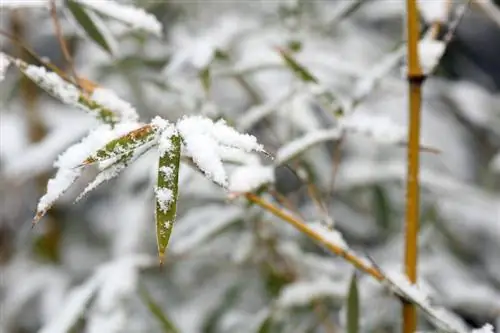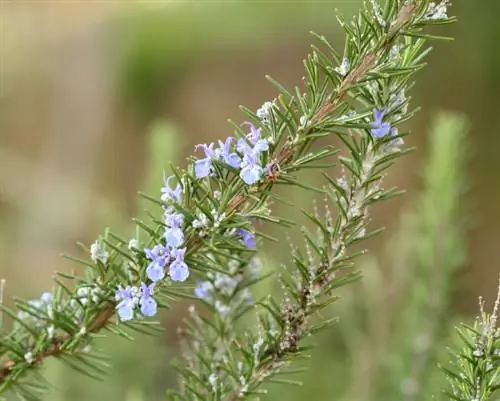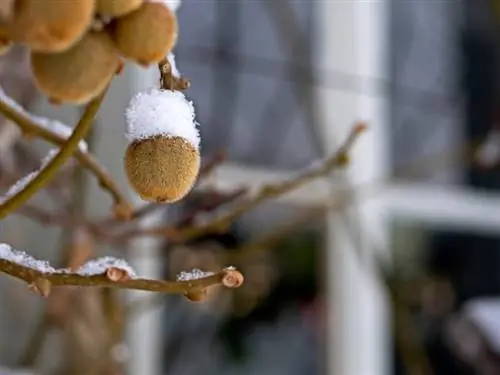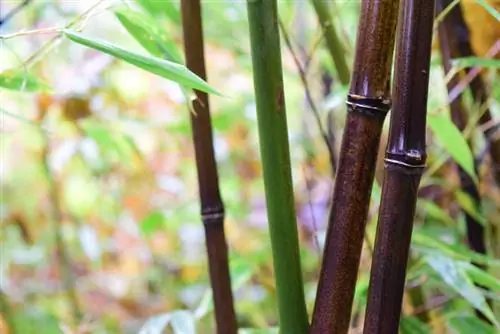- Author admin [email protected].
- Public 2024-01-05 20:48.
- Last modified 2025-01-23 11:19.
Winter gardens artfully decorated with bamboo can be found, especially in China. In German gardens, too, more and more winter-hardy bamboo species are shaping the cold season. Which types of bamboo can withstand the cold and how they can safely get through ice and snow.
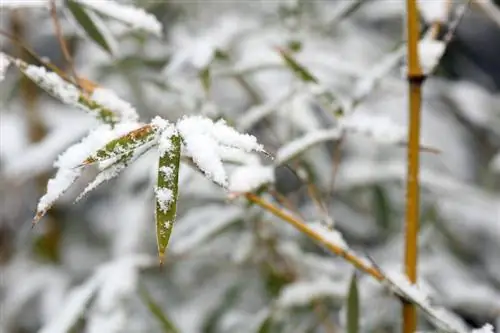
Which types of bamboo are hardy and suitable for the German garden?
Winter-hardy bamboo species such as Fargesia murielae, Phyllostachys bissetii and Phyllostachys aurea defy the cold and are suitable for the German garden. They stay green, but require a protected location and should be watered on frost-free days.
Winter-hardy bamboo varieties at a glance
If you want to enjoy green leaves in winter, bring evergreen, hardy plants into your garden. Whether outdoors in the garden or as a pot plant, these types of bamboo are particularly suitable for this:
- Fargesia murielae
- Phyllostachys bissetii
- Phyllostachys aurea
Bamboo Fargesia murielae Germany's most popular bamboo
This bamboo is one of the most popular evergreen garden plants in Germany. It impresses with characteristics such as being very hardy, forming clumps and growing bushy. Compared to the rhizome-forming bamboos, it does not spread underground. It grows like a perennial and is very bushy. Its stalks reach a height of 5 meters. Up to 10 branches, each with 6 leaves, grow from the nodes of the stalks. This growth habit is recommended for individual planting or for hedge design. Other very hardy bamboo plants of the Fargesia genus:
- Fargesia murielae Standing Stone
- Fargesia murielae Green Arrows
- Fargesia nitida is currently in bloom!!!
Phyllostachys bissetii not just for panda bears
It tolerates heat, cold, wind and drought better than other varieties with very good winter hardiness. Its good cutting tolerance makes it an all-rounder for every garden. It reaches a height of 8 meters and is therefore not only suitable as a solitary plant in a pot, but preferably as a hedge.
Good to know: Bamboo water can be used to brew a tasty tea from its freshly harvested leaves. Its sprouts can be eaten raw or to refine salads and vegetables. Panda bears also like to eat them.
Phyllostachys aurea the golden Peking bamboo
Phyllostachys aurea is also called Golden Peking Bamboo. Its yellow stalks that shimmer golden in the sun are always an eye-catcher. The young stalks take on a reddish color in the sun. It grows up to 7 meters high and is suitable in a pot or as a hedge bamboo. Phyllostachys aurea, along with Phyllostachys bissetii, is one of the hardiest bamboo species. Both can tolerate sub-zero temperatures down to -25° C. Like all Phyllostachys species, Phyllostachys bissetii and Phyllostachys aurea form underground root runners and therefore require a rhizome barrier (€78.00 at Amazon)!
What does the label say about plants that are hardy?
- Not hardy - temperatures around freezing point can only be tolerated for a short time or not at all.
- Moderately hardy - temperatures from -8° C to -15° C can be tolerated for a few days in a protected location.
- Good winter hardy - temperatures from -15° C to -20° C can be tolerated for a few days depending on the location.
- Very hardy - the plant can tolerate temperatures of -20° C to -25° C for a few days. Not from the leaves! Leaf damage may occur. In spring these leaves fall off and new ones form again.
Tips & Tricks
Water bamboo plants on frost-free days! Make sure that the root area does not dry out or freeze! Otherwise the roots will dry out and die.

